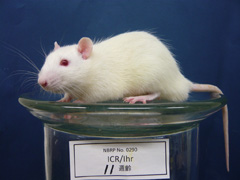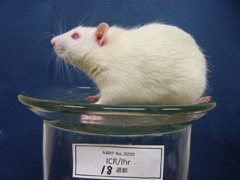| NBRP Rat No: 0290 |
Strain name: ICR/Ihr |
Commmon Name: ICR, Ihara's cataract rat, Inherited cataract rat |
Rat Genome Database |
| Principal Investigator: |
Nobuo Ihara Institute of ICR research 3-17, 4-chome, Matsuigaoka, Kyotanabe-city 610-0353 Kyoto Japan |
| Tel: 0774-62-6448 Fax: 0774-65-1123 |
Email: |
| Preservation Status: |
Embryo Sperm Living Animals |
 |
 |
| Coat Color |
albino (c) |
| Inbred Generations |
F?+1+12 (April 2012) |
| Usage Restrictions |
The recipient of BIOLOGICAL RESOURCE shall obtain a prior written consent on use of it from the DEPOSITORS. The recipient is requested to confer with DEPOSITORS, before publication, about the report on the investigated results obtained by using the RESOURCE. |
| Genetic Status |
|
| Comercial Availability |
|
|
| Research Category |
|
| Gene Affected |
|
| Origin |
The ICR is a hereditary cataractous strain developed by selective breeding by Ihara et al. of Kansai Medical University (Ihara, 1983). Ihara's cataract rat, Inherited cataract rat. (Oct 12, 2010) |
| Strain characteristics |
ICR rats exhibit spontaneous cataract at 3-4 months of age and mature it completely at 4-6 months of age (Ihara 1983). The cataractous change is progressive. In the lenses of ICR rats, increase of Ca2+ content with the decrease of Ca2+-ATPase activity, remarkable decrease of some kind of beta- and gamma-crystallin content, increase of C-terminal truncated alpha-crystallin, increase of NO and lipid peroxide (LPO) level, and accumulation of autolytic products by calpain are recognized (Takeuchi, 2000; Takeuchi, 2001; Takeuchi, 2004; Nagai, 2008). Eye drops with antibiotic DSF delays the lens opacification in ICR rats (Nagai, 2007; Nagai, 2008). The etiology of the cataract in ICR rats is different from that in UPL rats (NBRP No. 0217) and that in diabetic models (Nagai, 2008). (Oct 12, 2010) |
| Breeding Conditions |
|
| Genotyping |
|
| References |
Takashima M, Taniguchi K, Nagaya M, Yamamura S, Takamura Y, Inatani M, Oki M.
Gene profiles and mutations in the development of cataracts in the ICR rat model of hereditary cataracts.
Sci Rep. 2023 Oct 24;13(1):18161.
Ihara N.
A new strain of rat with an inherited cataract.
Experientia. 15;39(8):909-11, 1983.
Takeuchi N, Kamei A.
Crystallin proteins in lenses of hereditary cataractous rat, ICR/f.
Biol Pharm Bull. 2000 Mar;23(3):283-90.
Takeuchi N, Ouchida A, Kamei A.
C-terminal truncation of alpha-crystallin in hereditary cataractous rat lens.
Biol Pharm Bull. 2004 Mar;27(3):308-14.
Takeuchi N, Ito H, Namiki K, Kamei A.
Effect of calpain on hereditary cataractous rat, ICR/f.
Biol Pharm Bull. 2001 Nov;24(11):1246-51.
Nagai N, Ito Y, Takeuchi N.
Inhibitive effects of enhanced lipid peroxidation on Ca(2+)-ATPase in lenses of hereditary cataract ICR/f rats.
Toxicology. 2008 May 21;247(2-3):139-44.
Nagai N, Takeda M, Ito Y, Takeuchi N, Kamei A.
Delay in ICR/f rat lens opacification by the instillation of eye drops containing disulfiram and hydroxypropyl-beta-cyclodextrin inclusion complex.
Biol Pharm Bull. 2007 Aug;30(8):1529-34.
Nagai N, Ito Y, Takeuchi N.
Effect of disulfiram eye drops on lipid peroxide formation via excessive nitric oxide in lenses of hereditary cataract ICR/f rats.
Biol Pharm Bull. 2008 May;31(5):981-5. |
| Additional strain information |
|
|
|